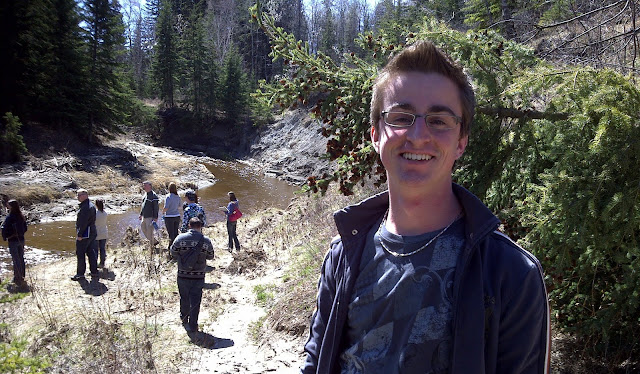 |
Photo 4: King's University's Geography 201 field trip to Whitemud Creek, Edmonton, Alberta. 2011-05-04 |
Earth System
The Earth consists of five interacting spheres, five facets of the larger Earth System. In the image above (Photo 3), we see four of the five spheres. The atmosphere begins a few meters within the soil and oceans up to about 60,000 km above the Earth, forming a blanket of air around the earth that regulates the weather patterns. The lithosphere (lithos means rock) is the solid outermost layer of the Earth, consisting of land, mountains, and seafloors. The hydrosphere contains all the water bodies on the Earth. The biosphere refers to animal, plant, and human life. Not in this photo is the cryosphere, the frozen water on the Earth, including glaciers, floating ice, snow cover, and permafrost. The cryosphere has its own distinct properties and is thus regarded as separate from the other four, even though most of this sphere could be counted within the hydrosphere. The key for understanding here is that these systems interact and influence each other. Understanding each sphere and how they affect each other is a main theme is physical geography.
 |
| Photo 5: My father and I at a beach in western France. 2005-07-07 |
The continents and oceans
Earth has 6 so called continental landmasses making up 29% of the earth’s surface: Africa (30,300 km2), South America (17,870 km2), North America (24,350 km2), Eurasia (54,650 km2), Australia (8,290 km2), and Antarctica (13,990 km2); as well, our planet consists of 71% water and ice and has 5 main oceanic bodies: the Pacific, Indian, North Atlantic, South Atlantic, and the Southern Ocean around Antarctica. Smaller water bodies include the Arctic Ocean and the Mediterranean Sea.
The picture above is on the beach of western France, looking out over the North Atlantic Ocean. Percentages and numbers make the world sound small, but I always find that a visit to the beach, like here in France, puts these numbers into perspective. Compared to our human size, the Earth is breathtakingly large. Not all the Earth’s land is livable, so the area in which permanent residence is possible is called the ecumene.
The Oceans dividing the land are not just big water basins but have unique and different regions: the continental shelf is the gently sloping extension of landmasses into oceans that reaches up until the continental slope, at which the ocean becomes much deeper quickly, continental rises are often at the foot of these slopes and have again a much gentler downward slope, at the bottom of the ocean floor are the relatively flat abyssal plains with occasional deep trenches, and at the meeting of some of the continents there are the mid-oceanic ridges full with volcanic activity and marine wildlife.
No comments:
Post a Comment